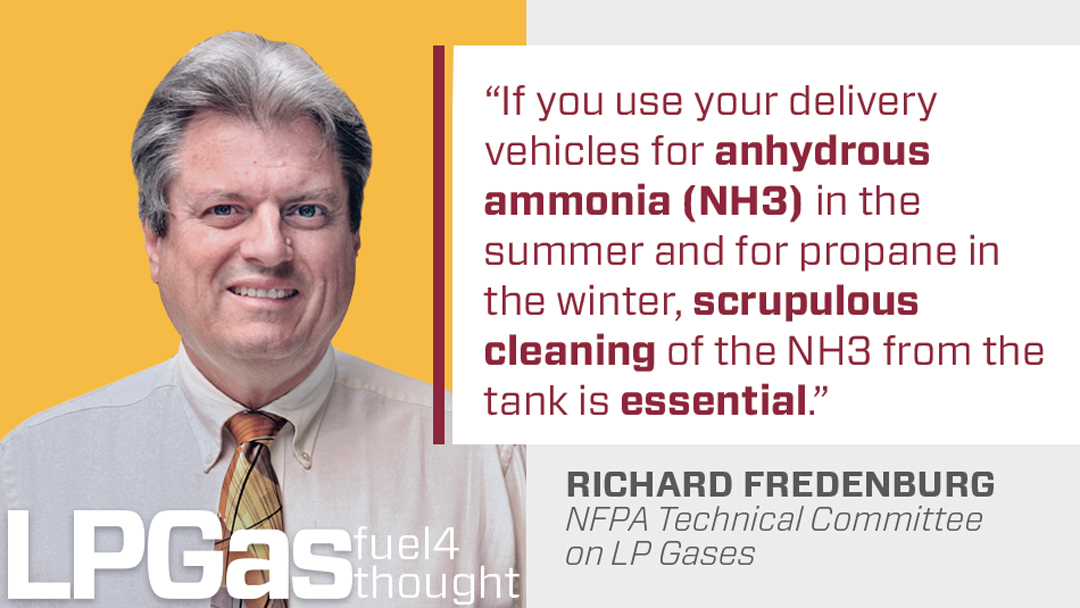Watch out for anhydrous ammonia contamination
Colder weather will be upon us as the months march on.
That will be a blessed relief for many of us. It means it is time for some marketers to convert their delivery vehicles from anhydrous ammonia (NH3) to propane.
The problem with NH3 contamination is that ammonia in any form, anhydrous or not, attacks the copper in copper alloys, including brass, and causes stress corrosion cracking. This causes the copper alloy to become brittle and susceptible to failure from any number of causes, including pressure in a container. Mixing NH3 and propane in a tank is corrosive and leads to very high pressures, a bad combination. Interestingly, the higher strength containers are more susceptible to stress corrosion cracking than lower strength containers.
One worrisome problem we dealt with for years was contaminated grill cylinders that were used in illegal methamphetamine production. According to some cylinder exchange companies, the number of contaminated cylinders is way down, but you should still know the signals. The brass valve on a cylinder will turn blue green when exposed to NH3. Don’t refill such a contaminated cylinder, and be wary of its contents.
Code notes
If you use your delivery vehicles for NH3 in the summer and for propane in the winter, scrupulous cleaning of the NH3 from the tank is essential.
Section 4.5 of the NFPA 58 Liquefied Petroleum Gas Code requires testing to ensure propane is not contaminated in vehicles previously used for NH3. There must be “less ammonia than is required to turn the color of red litmus paper to blue.” This test is required prior to initial use or transfer of LP gas after it has been converted from ammonia service. The test is important to protect the brass and copper in any propane storage tank, valves, regulator, piping and appliances you supply. There is also some evidence that when a NH3/propane mixture is burned, it generates cyanide gas. We don’t want to expose the chef preparing dinner to that.
NFPA 58 prohibits conversion of former NH3 tanks of 3,000 gallons or less to LP gas use. See section 5.2.1.5. Some extensive material was presented to the 58 committee many years ago, showing how the steel of some tanks peeled off in layers after conversion, rendering the tank unsound.
Another prohibition to conversion can be found on some NH3 tank nameplates. Some of them indicate it’s for NH3 use only. One of the reasons has to do with the relief valve sizing. The commonly found 0.75-in. pressure relief valve opening is not big enough for the flow rate needed for propane relief, usually a 1.25-in. opening.
I know most of you will not encounter NH3 in your workplace. For those who do, you must be trained on storing, transporting and handling it. It can be dangerous to your health, as it is very toxic. It doesn’t burn well, so its hazard level is a trade-off.
I can attest to the dangers of NH3. I was in training one day when I got a snoot full of it. I was not happy.
I was approaching an open bucket of the stuff from upwind so I could test with my litmus paper. Sure enough, the paper turned blue. Then, the wind shifted, and it blew toward me. It immediately made my eyes burn, and my breathing became difficult. I hightailed it away, turning upwind. It was several seconds before I could breathe and a few minutes before I was back to normal.
I expect my dose was minimal. I wasn’t supposed to be dosed at all since I was following directions and depending on the wind to keep the NH3 away from me. I hate to think what a heavier dose is like.
Water troughs and personal protective equipment such as goggles, gloves and waterproof garments are the main safety equipment. Follow your training instructions.
Learn more about NH3 from the Minnesota Department of Agriculture.
Richard Fredenburg is an LP gas engineer at the North Carolina Department of Agriculture and Consumer Services, Standards Division. He is also a member of NFPA’s Technical Committee on LP Gases. Contact him at richard.fredenburg@ncagr.gov or 984-236-4752.
NOTE: The opinions and viewpoints expressed herein are solely the author’s and should in no way be interpreted as those of LP Gas magazine or any of its staff members.

















